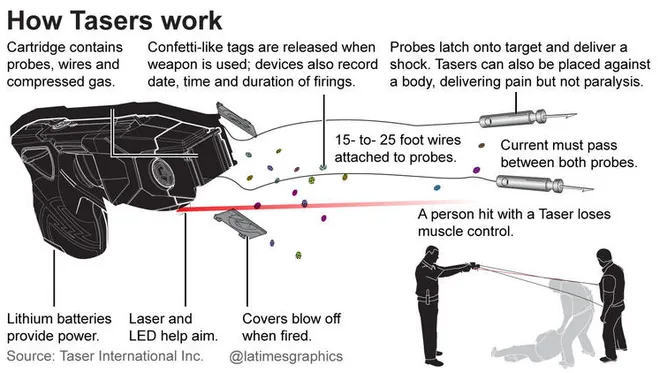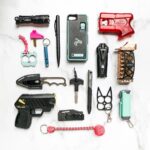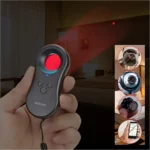Stalking, assault, and muggings are unfortunate realities in today’s world, making personal safety a paramount concern for many, particularly vulnerable groups like women and the elderly. According to FBI statistics, over 200,000 assaults against individuals aged 12 and up were reported in 2020 alone. This escalating issue underscores the growing need for discreet yet effective self-defense tools. Among these, personal Tasers stand out as a groundbreaking innovation, rapidly gaining popularity and revolutionizing the way people approach their own safety in hazardous situations.
This comprehensive guide will explore the emergence of personal Tasers, how they work, legal considerations, who they aim to protect, and whether they present a viable self-defense option for today’s world. Let’s dive in.
The Evolution of Personal Safety Gear

For centuries, people have sought methods to shield themselves from harm. Early techniques centered on hand-to-hand combat training and crude weapons like clubs. By the 1800s, firearms entered the scene but required extensive training and presented lethal risks if used improperly.
In the 1900s, innovative non-lethal tools emerged offering alternatives for personal defense. These first generation devices included pepper spray, kubotans, and stun guns. While helpful in some cases, each solution had limitations:
- Pepper Spray – Cheap at $10-$15 per canister but often subject to wind blowback or ineffective on assailants who are intoxicated.
- Kubotans – These keychain-sized batons must be used at very close range to inflict pain and stop attackers.
- Stun Guns – They require prolonged contact with the attacker’s body to effectively disrupt the nervous system.
The personal Taser overcame many of these drawbacks by using electricity to temporarily immobilize attackers from safer distances. But the road to this ingenious innovation was long.
Invented in 1974 by NASA researcher Jack Cover, the first Taser devices were bulky and relied on gunpowder. It wasn’t until 1993 that modern electroshock Tasers were designed by brothers Rick and Thomas Smith. Their company, Taser Systems, debuted the first consumer model – the Taser TF1 – in 1994 at a price of $1,495.
Since then, personal Tasers have improved in capabilities while reducing in size. Advancements like the addition of anti-grab technology help protect against assailants attempting to tear the device away. Safety features and power regulation also ensure a controlled charge that is unlikely to cause permanent injury or death under normal circumstances.
While still requiring responsible usage and training, personal Tasers have evolved into one of the most versatile, discreet and effective self-defense options available today. But how exactly do they work to stop attackers so successfully?
How Personal Tasers Work

The Science Behind It
When the Taser trigger is pulled, an electrical signal is discharged through insulated wires that eject tiny probes attached to the ends. These barbed probes pierce through clothing and penetrate a tiny distance into the attacker’s skin or tissue.
The resulting high voltage, low amperage shock interrupts communication between the brain and muscles via the peripheral nervous system. This causes involuntary, neuromuscular incapacitation – essentially immobilizing the assailant temporarily by inducing muscle spasms and loss of control.
Law enforcement models output up to 50,000 volts – well above the 120 volts from a standard household outlet. However, civilian Tasers utilize a lower voltage for two key reasons:
- To reduce risks from accidental or improper use.
- To comply with personal safety regulations limiting civilian voltage levels.
Popular consumer models like the Sabre Taser and Vipertek VTS-989 emit 1,500 to 2,000 volts respectively. While less powerful, this is still sufficient to temporarily incapacitate attackers.
Consumer Tasers compensate for lower voltage by allowing longer discharge times. Holding down the trigger can deliver up to 30 seconds of continuous shock, giving the user ample time to enact an escape.
Safety Measures
Responsible design also ensures today’s personal Tasers are relatively safe when used properly. Features like safety switches prevent accidental firing while laser sights improve aim on target areas.
Anti-grab technology makes it difficult for an assailant to tear the Taser away during discharge. This helps avoid the risk of an attacker redirecting the device back on the victim.
Education and training resources by reputable brands like Vipertek also teach critical lessons including:
- Proper cleaning of electrodes to maintain electrical flow.
- Avoiding accidental deployment through proper storage.
- Usage only in lawful self-defense situations as a last resort.
While no weapon is completely without risks, Tasers offer a favorable safety profile compared to alternatives, especially firearms. Still, responsible handling is imperative. Let’s look at some of the regulations surrounding ownership and use.
Taser Legality and Restrictions
As non-lethal self-defense tools, personal Tasers are broadly legal for civilian use across much of America. However, some states and municipalities do impose restrictions around ownership or usage. It’s critical to be aware of these laws in your local area before making a purchase.
State Level Regulations
| State | Is it legal to have a stun gun or Taser? | Do I need a permit to own a stun gun or Taser? |
|---|---|---|
| Alabama | Yes | No |
| Alaska | Yes | No |
| Arizona | Yes | No |
| Arkansas | Yes | No |
| California | Yes | No |
| Colorado | Yes | No |
| Connecticut | Yes | No |
| Delaware | Yes | No |
| District of Columbia | Yes | No |
| Florida | Yes | No |
| Georgia | Yes | No |
| Hawaii | No | N/A |
| Idaho | Yes | No |
| Illinois | Yes* | Yes |
| Indiana | Yes, for stun gun** | No |
| Iowa | Yes | No |
| Kansas | Yes | No |
| Kentucky | Yes | No |
| Louisiana | Yes | No |
| Maine | Yes | No |
| Maryland | Yes | No |
| Massachusetts | Yes | No |
| Michigan | Yes, with a concealed carry permit | Yes |
| Minnesota | Yes | No |
| Mississippi | Yes | No |
| Missouri | Yes | No |
| Montana | Yes | No |
| Nebraska | Yes | No |
| Nevada | Yes | No |
| New Hampshire | Yes | No |
| New Jersey | Yes | No |
| New Mexico | Yes | No |
| New York | Yes | No |
| North Carolina | Yes*** | No |
| North Dakota | Yes | No |
| Ohio | Yes | No |
| Oklahoma | Yes | No |
| Oregon | Yes | No |
| Pennsylvania | Yes | No |
| Rhode Island | No | N/A |
| South Carolina | Yes | No |
| South Dakota | Yes | No |
| Tennessee | Yes | No |
| Texas | Yes | No |
| Utah | Yes | No |
| Vermont | Yes | No |
| Virginia | Yes | No |
| Washington | Yes | No |
| West Virginia | Yes | No |
| Wisconsin | Yes | No |
| Wyoming | Yes | No |
In Illinois, it is legal to own a stun gun or Taser, but a Firearm Owner’s Identification (FOID) card is required to purchase or possess one.
In Indiana, it is legal to own a stun gun, but a license is required to carry one outside of the home. Tasers are considered firearms and require a license to own and carry.
In North Carolina, it is legal to own a stun gun or Taser, but they cannot be carried in certain locations such as schools and government buildings.
Source: Stun Gun Laws by State: The Legal Guide for 2023 | Lawrina. Link to source
At the state level, civilian Tasers are legal in 45 states at the time of this writing. Only Hawaii, Massachusetts, New Jersey, New York, Rhode Island, and the District of Columbia prohibit private citizen ownership. Some states allow ownership but restrict where personal Tasers can be carried such as schools or government buildings.
In the state of Wisconsin for example, ownership of electric weapons like Tasers is permitted for those over 18 but banned from educational facilities unless the carrier has a concealed carry permit. States like Maryland similarly permit ownership but prohibit carrying in public establishments that serve alcohol.
Local and City Ordinances
In addition to statewide laws, local county and city statutes can also impose further restrictions that affect personal Taser legality for residents.
For instance, while broadly permitted at the state level, the city of Philadelphia bans possession or use of any “electronic incapacitation device” including Tasers. Chicago imposes a similar ban for private citizens. Other cities like Washington D.C. allow possession but restrict carrying concealed Tasers outside the home.
Permits and Background Checks
Some states such as Michigan require a background check to confirm the buyer does not have felony convictions or mental health issues that might legally prohibit Taser ownership. Permits for concealed carry may also be mandatory in certain municipalities like Denver, Raleigh, and Honolulu.
When in doubt, check with local law enforcement agencies on possession, permitting, and usage policies in your area. While powerful protection, Tasers must be acquired and handled lawfully.
Targeting Vulnerable Populations
Along with growing adoption, marketing outreach has shifted to focus on vulnerable demographics who can benefit greatly from discreet self-defense options. College students and the elderly are two groups being explicitly targeted recently.
Women
Women arguably remain the most heavily targeted market. Statistics from the Department of Justice confirm females face disproportionately high risks of sexual assault and domestic violence.
Recent ad campaigns directly showcase petite female models able to stop large aggressive male attackers with ease using a compact Taser.
The message conveyed is one of empowerment and reclaiming control. And the approach appears to be resonating. TASER International reported 60-65% of personal Taser buyers in 2009 were women.
Lightweight, unintimidating models like the Taser Pulse II which weighs just 5.5oz are designed with female self-defense in mind.
Vibrant colors and sleek aesthetics remove the stigma some associate with guns and traditional weapons. As Taser International’s Director of Communications Steve Tuttle remarks, “It looks like you’re carrying a cell phone.”
College Students
Marketing efforts also target college students living on campuses which FBI data shows are high-risk areas for assaults including rape and other sex crimes. Nearly 26,000 incidents were reported on US college campuses in 2020.
Models like the compact Taser Pulse II appeal to students seeking discreet protection walking to night classes or dorms. Major brands offer free training webinars and educational resources catered to young adults as well.
The Elderly
Seniors represent another vulnerable group that can greatly benefit from personal Tasers. With declining mobility and reaction times, Tasers offer the elderly an equalizer against threats and the ability to defend themselves fromunsafe distances.
Statistics confirm the need. According to the National Crime Victimization Survey, over 51,000 violent victimizations against those aged 65+ were reported in 2020. Personal Tasers empower vulnerable seniors to regain their security.
By targeting demographics most exposed to harm, forward-thinking brands are spreading access to cutting-edge protection for those who need it most. But an important question remains – just how effective are personal Tasers compared to alternatives?
Cost and Effectiveness
While generally more expensive than other self-defense products, statistics confirm personal Tasers offer unmatched stopping power and versatility for the investment. They are worth the cost for most seeking reliable protection.
Pricing
Popular Taser models for personal use like the Sabre Taser and Vipertek VTS-989 retail around $350 to $400.
By comparison, most pepper sprays cost just $10 to $20 while kubotans and stun guns usually range from $15 to $100 on average.
Based purely on upfront pricing, a Taser is one of the pricier options. However, when factoring in effectiveness and lifecycle value, it emerges as a worthwhile investment for serious self-defense needs.
Performance Statistics
Independent studies by law enforcement and consumer groups highlight the unmatched effectiveness of Tasers in quickly neutralizing threats:
- Stopping Power – Personal Tasers achieve muscle incapacitation 95% of the time per field tests. This exceeds the average 50% effective rate for pepper spray.
- Speed – The shock immediately and involuntarily impairs assailants in just 3 seconds on average. By contrast, it takes 5 seconds for pepper spray to take effect.
- Duration – A single 30-second Taser discharge exceeds most pepper spray canisters providing just 8 to 10 seconds of spray.
- Accuracy – Laser targeting ensures accurate hits on attackers up to 15 feet away despite conditions. Pepper spray is impacted by wind and humidity.
- Versatility – Cartridges provide up to 500 shocks from safe distances. Pepper spray effectiveness reduces significantly beyond 5 feet and is single use.
While upfront cost is higher, this data confirms Tasers offer unmatched stopping ability per use. Their electrical stopping power trumps temporary chemical irritation from pepper spray.
In life and death situations, performance takes priority over price. As Theresa Cleland, owner of Jane’s Due Process remarks, “It takes a considerable amount of skill for a handgun to be useful in self-defense. With Tasers and stun guns, all you have to do is make contact.”
What Consumers Should Consider
Personal Tasers present a compelling case for effective self-defense. But like any weapon, they must be acquired and handled with care and wisdom. Here are some key considerations for those exploring a purchase:
Legal Responsibilities
Tasers are classified as firearms in some states and banned for civilian usage in others. Always research local laws and tread carefully to avoid legal issues. Usage should be limited to lawful self-defense only.
Proper Training
Free online courses offered by major brands like Sabre are invaluable for learning proper handling, care and deployment. Hands-on training is ideal but web resources can still effectively educate you.
Physical Precautions
Avoid using Tasers around flammable gases or explosives. Also be cautious using them on assailants with pre-existing health conditions which could increase safety risks.
Situational Awareness
While valuable protection, situational awareness remains your best defense. Avoid unlit areas at night, conceal valuables in public, and be aware of suspicious persons. A Taser should be a last resort.
Non-Lethal Defense
Tasers offer effective defense while avoiding the irreversible harm of lethal weapons. This aligns with ethical obligations to avoid permanent injury when possible. With practice, Tasers can stop threats while preserving life.
While not completely risk-free, Tasers used lawfully and properly offer reasonable odds of stopping threats with a favorable safety profile. But more research may be needed before deciding if owning one feels right for you.
Conclusion
Personal Tasers have transformed consumer access to safe, highly effective self-defense options. Compact, lightweight and discretely concealable, yet powerful enough to quickly stop threats from safer distances.
As this guide has shown, Tasers have compelling benefits with real risks that must be carefully weighed based on your personal situation. If exploring the option further, we recommend starting with Taser brand websites which offer helpful materials like product comparisons, training, and legal guidelines.
To experience holding a Taser safely and ask additional questions, visit your local gun shop or sporting goods store and ask to handle a demo unit while strictly following employee instructions of course. Stay vigilant and stay safe in today’s world. Your protection is what matters most.


